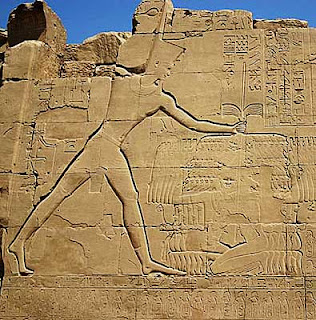Empire of Ancient Egypt
Sep 26, 2010
Empire of Ancient Egypt
An Egyptian called his homeland Kemet. His world was divided into lowland kemet (“black land”), the narrow ribbon of rich, black earth on the valley floor, and highland deshret (“red land”), the pale, reddish sand of the forbidding desert plateaus. Foreigners were “highlanders.”
“Going up” meant leaving the valley; “descending” was returning home.
Because all life came from the Nile, geography was everything in ancient Egypt Egypt Aswan Upper Egypt ’s floodplain totaled 42,500 square miles. Cultivated lands ex-tended from just over one and a half miles wide at Aswan
About 100 miles south of the Mediterranean, the Nile split into two streams and many smaller tributaries. It formed the fan-shaped Nile Delta, an 8,500-square-mile region of marsh and heavily silted land called Lower Egypt , Ta-Mehu (“water-filled land”).
The ancient Nile had at least five, and as many as 16, outlets to the sea. (The modern Nile has only two, Rosetta and Damietta Nile , the ancient Faiyum was a wetlands paradise, thick with lotus and papyrus plants and teeming with birds and animals. Birket Qaran, a lake in the northern Faiyum, was a favorite hunting spot.
plants and teeming with birds and animals. Birket Qaran, a lake in the northern Faiyum, was a favorite hunting spot.
The Nile (then and now) blends two major streams. The White Nile rises from the clear waters of Lakes Victoria, Albert, and Edward in central Africa . As it flows north, it gathers water from over 1,500 miles of tributaries. The Blue Nile rises in Lake Tana, in the highlands of Abyssinia (modern Ethiopia White Nile . The two streams join at Khartoum , capital of the modern Republic of the Sudan
140 miles north of Khartoum , the Atbara River , rising from the Ethiopian highlands, joins the Nile .
Near Khartoum , the Nile enters a region of hard sandstone. As it runs through this difficult land, there are six lengths—the cataracts—where it has been unable to carve a clear channel. Stony outcroppings, rapids, and small but treacherous falls obstruct navigation. The northernmost cataract (the first) is closest to Egypt Aswan
Nile to carve a relatively straight channel.
After passing the island of Elephantine , the Nile enjoys a 675-mile, un-obstructed passage to the Delta and the Mediterranean Sea .




0 comments:
Post a Comment